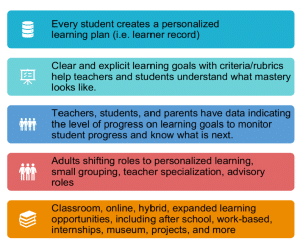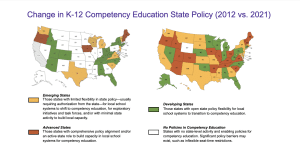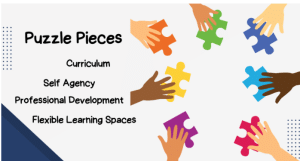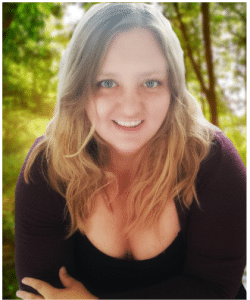An Introduction to Competency-Based Education with Students and School Leaders
CompetencyWorks Blog
On January 25th, CompetencyWorks Program Director, Laurie Gagnon, led Aurora Institute’s “An Introduction to K-12 Competency-Based Education Webinar” along with special guests from Harrisburg School District and South Bronx Community Charter High School. She opened the webinar with guiding ponderings for the event:
- What is competency-based education (CBE)?
- How does CBE culture, pedagogy, and structure, center students and equity?
- What policies and practices are needed to enable the shift to CBE systems?
Competency-based education exists to eliminate the one-size-fits-all industrial model of American schooling. Rather than focusing on student learning, the school system as it stands focuses on, “delivering curriculum over a predetermined time period.” This traditional model of education allows students to advance with gaps in their learning. In fact, “We allow students to move ahead with a 70% or 80%, which means they missed 20% or more of the content and we don’t know what we missed or if it’s essential in learning the next thing.”
 This results in high school students on an elementary school level in math and reading. What’s worse is that the system does not slow down or mend the learning gap. Because they are in a time crunch to complete the curriculum, schools push forward with the learning and push students to the next level before they have mastered the material.
This results in high school students on an elementary school level in math and reading. What’s worse is that the system does not slow down or mend the learning gap. Because they are in a time crunch to complete the curriculum, schools push forward with the learning and push students to the next level before they have mastered the material.
CBE, by contrast, is focused on constant learning that varies as a function of time for individual students. As importantly, CBE works on the intentional and meaningful application of both knowledge and skills. Schools choose to switch to competency-based models for a variety of reasons including pursuing equity, engaging in deeper learning, and responding to COVID-19 learning loss. This model of education addresses the flaws in the traditional education system by individualizing learning, establishing student agency, and meaningfully tracking growth.
Getting started with CBE is as individualized for learners as it is for schools, districts, and states. There is no checklist that tells you exactly how to pivot toward competency-based learning. It isn’t a system schools can buy or do simple training to implement. Despite this deterrent, the education system has embraced a new way of thinking. In fact, CBE has grown rapidly in the United States, with nearly all states taking at least some steps toward policies that allow or actively support this approach.
 Although there is no terminal task list for establishing competency-based education at schools, CompetencyWorks provides a basic framework to kickstart this transformation:
Although there is no terminal task list for establishing competency-based education at schools, CompetencyWorks provides a basic framework to kickstart this transformation:
- Frame the change with a vision and a coalition of stakeholders
- Build capacity for change through professional development and a sharing of resources
- Support and enable change with relevant policy and both collecting and disseminating holistic and inclusive data
During the webinar, guests from Harrisburg Community Schools and South Bronx Community Charter High School explored practical models of competency-based education.
LEARN ABOUT CBE BASICS (0:00-11:25)
Competency-Based Elementary Education
Harrisburg School District is a rapidly growing district in South Dakota. Travis Lape, Innovative Programs Director, works for the district on their unique program. The development of CBE began at the high school level, where the school “gave [teachers] autonomy and…time, and they started to build…our customized learning environment”.
However, the school quickly realized that incoming freshmen were set in the traditional model and unprepared to rewire their minds around schooling. They wanted to balance the puzzle pieces of curriculum, self-agency, professional development, and flexible learning spaces to create a great school culture. Because of this, they expanded the program to the middle school level and eventually the elementary school level.
 Two primary-level students, Haley and Nash, joined Mr. Lape to explore their particular model. At Harrisburg School District, students are not assigned a grade level. Instead, they are defined as Littles, Middles, Molders, and Olders. As students learn they switch from studio to studio for their different subjects. On life in a competency-based school, Haley said, “I use thinking about my thinking a lot,” both inside and outside of class. Haley is an Older who dotes on the younger students in her multi-age studio. “It’s very fun because…they will definitely come up to you if they need help.” Working with younger children allows her to build confidence and leadership skills.
Two primary-level students, Haley and Nash, joined Mr. Lape to explore their particular model. At Harrisburg School District, students are not assigned a grade level. Instead, they are defined as Littles, Middles, Molders, and Olders. As students learn they switch from studio to studio for their different subjects. On life in a competency-based school, Haley said, “I use thinking about my thinking a lot,” both inside and outside of class. Haley is an Older who dotes on the younger students in her multi-age studio. “It’s very fun because…they will definitely come up to you if they need help.” Working with younger children allows her to build confidence and leadership skills.
Molder, Nash, found the initial use of multi-age studios challenging as he began to switch between multiple rooms but quickly adjusted. After a while, he said, “I got more used to it…I adapted to the change of studios and everything.” Now, he loves it! He enjoys learning about new people and different ways of doing things. Despite switching studios, students have a core group of facilitators that stay with them throughout their elementary experience. Looping in this way allows them to build deeper bonds with the educators and create strong trust.
LEARN MORE ABOUT HARRISBURG COMMUNITY SCHOOLS (11:26-35:13)
Competency-Based High School Education
John Clemente, Co-Founder and Executive Director of South Bronx Community Charter High School transitioned the conversation to CBE application in high schools. As the young school was designed, they developed a theoretical framework and let it bloom. They cite their unconventional first few years as formative while they collected best practices to structure the school and, “organized in what we felt was the most compelling way.” What resulted was the EPIC model of competency-based learning at the school. EPIC focuses on empowerment, personalized learning, inclusion & service, cultural responsiveness, continuous growth, and collective responsibility. It shapes how everything in the school is run, down to the CORE Curriculum.
developed a theoretical framework and let it bloom. They cite their unconventional first few years as formative while they collected best practices to structure the school and, “organized in what we felt was the most compelling way.” What resulted was the EPIC model of competency-based learning at the school. EPIC focuses on empowerment, personalized learning, inclusion & service, cultural responsiveness, continuous growth, and collective responsibility. It shapes how everything in the school is run, down to the CORE Curriculum.
Upon entering the school, students are assigned an advisor who becomes their CORE teacher. Their advisor works with students on developing social-emotional skills and aiming to create, “happy, healthy, holistically productive members of the community.” According to senior, Mari, the CORE aims to “push all students to learn how to do life outside, while in school.” This happens through internships and other opportunities that explore both social-emotional growth and college and career readiness.
Classes focus on multidisciplinary learning and projects that transcend daily lesson plans. One such project culminated with a think tank challenge at Google in downtown Manhattan. The overall goals of the unit, the experiences, and the takeaway skills are more important than the standards being covered during the lesson, though the standards were one source for the 66 required “attainments” for graduation. Another student, Louisianny, pointed out that the school does not ignore academics, but rather integrates them naturally into the rest of a student’s development. This creates fully developed individuals with unique experiences and interests.
LEARN MORE ABOUT SOUTH BRONX COMMUNITY CHARTER SCHOOL (35:14-54:58)
For the full list of resources, or to follow along with the webinar, visit the slides and video recording.
Learn More
- Getting Started with Personalized Learning: Resources for Education Leaders, Teachers, and Policymakers
- Competency Frameworks and Content Selection at South Bronx Community Charter
- District-wide Transformation in Harrisburg, South Dakota
 Alyssa Weaver is the Policy Research Intern at Aurora Institute’s CompetencyWorks program. She is finishing her second masters degree in public policy at the University of Chicago, where she focuses on education policy. She is a board member of the Education Policy Student Association and a production assistant for Pencils Down, the University of Chicago Public Policy Podcast’s show about education policy. She was a former teacher of seven years and taught informal science education, preschool, and most recently, 5th-grade math. She has spoken at conferences and schools on COVID-19 learning loss, project-based learning, multidisciplinary STEM integration, and green spaces for equity. Most recently, she was published as a guest author on Bored Teachers, for whom she wrote about the ethical use of AI in the classroom.
Alyssa Weaver is the Policy Research Intern at Aurora Institute’s CompetencyWorks program. She is finishing her second masters degree in public policy at the University of Chicago, where she focuses on education policy. She is a board member of the Education Policy Student Association and a production assistant for Pencils Down, the University of Chicago Public Policy Podcast’s show about education policy. She was a former teacher of seven years and taught informal science education, preschool, and most recently, 5th-grade math. She has spoken at conferences and schools on COVID-19 learning loss, project-based learning, multidisciplinary STEM integration, and green spaces for equity. Most recently, she was published as a guest author on Bored Teachers, for whom she wrote about the ethical use of AI in the classroom.